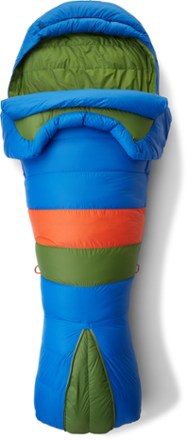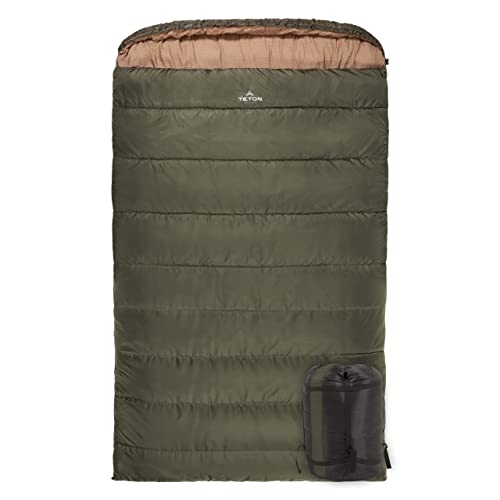When braving the cold for winter camping, choosing the best winter sleeping bag is paramount. Having the wrong bag can be seriously dangerous.
This guide dives deep into top-rated cold-weather sleeping bags, factoring in temperature rating, insulation, comfort, cost and more. Whether you’re winter backpacking, mountaineering, or just camping in the snow, we’ve got you covered. Let’s help you find the ideal sleeping bag to keep the cold at bay.

Our Top Picks
Best Overall
Nemo Sonic 0
Best 2-Person
TETON Sports Celsius Mammoth Double
Best for Backpacking
Western Mountaineering 10
Best Overall
Nemo Sonic 0
The Nemo Sonic 0 is a spacious and comfortable winter mummy bag, offering extra room for movement, suitable for all sleeping positions, and is surprisingly lightweight. While its wide cut means slightly less insulation than others in its price range, it’s rated for 0° F and filled with 850 down.
Key features include a large hood, tight-sealing draft collars for warmth, unique zippered vents for ventilation, and durable 40-denier and 20-denier ripstop fabric for longevity.
What We Like:
- Spacious
- Very Lightweight
- Lots of Features
What We Don‘t Like:
- Not as Well-Insulated as Other Models
Best Double Sleeping Bag
TETON Sports Celsius Mammoth Double Sleeping Bag
The TETON Sports Celsius Mammoth Double Sleeping Bag is the perfect economy bag to snuggle up and stay warm with your significant other!
In addition to not breaking the bank, this bag features a lifetime warranty, a no-snag 2-way zipper, and draft tubes that help keep the cold out.
What We Like:
- Great value for a double sleeping bag.
- Lifetime Warranty
- No-Snag 2-Way Zipper
- Effectively keep the cold air out, enhancing warmth.
What We Don’t Like:
- Hard to get back into its storage bag
Best for Winter Backpackers
Western Mountaineering 10
The Western Mountaineering 10 is warm, lightweight, and packs down very small.
It boasts 850-fill down for an excellent warmth-to-weight ratio. It also compresses easily for superior packing. In fact, this is one of the lightest winter sleeping bags around. That said, it’s still not restrictive (although it is narrower than other models). Additional highlights include a wide raft collar, well-fitting hood with drawstring, and snag-free zipper.
Although this Western Mountaineering bag is a great choice for all winter campers, it’s ideal for long-distance winter backpacking where lightweight is a prime concern.
What We Like:
- Lightweight
- High Warmth-to-Weight Ratio
- Snag-Free Zipper
What We Don’t Like:
- Shallow Hood
Budget Option – Low Temp (0-20°F)
Coleman North Rim Mummy Sleeping Bag
The Coleman North Rim Mummy Sleeping Bag is a popular choice known for its reliability and warmth, reflecting Coleman’s strong reputation in camping gear.
What We Like:
- Suitable for 0-10°F, ideal for cold weather.Effectively retain heat inside the bag.
- Adds extra warmth for feet.
- Ensure a snug fit to keep warmth in.
What We Don’t Like:
- Bulky
- Not great for taller campers
Marmot Sawtooth 15

The Marmot Sawtooth 15 is an excellent winter sleeping bag for casual campers looking for something that is reasonably priced but not lacking in performance.
Although it’s not quite as warm as others on our list, the 650 down powder does a good keeping you warm at night. Throw in a number of features designed to make the bag easier to use and more comfortable, like anti-snag zippers and a wrap-around foot box, and it’s easy to see why this bag is so popular.
Remember that although this winter sleeping bag works well for casual winter camping, it’s not warm enough for serious winter conditions. The trade-off is that you won’t get sweated out nearly as much if you use this bag in spring or fall.
What We Like:
- Affordable
- Reasonably Warm
- Anti-Snag Zippers
What We Don‘t Like:
- Least Warm On Our List
Best for Mountaineers
Marmot Col -20
The Marmot Col -20 is one of the warmest and most weatherproof winter sleeping bags available today.
It’s rated for temperatures down to -20°F. Yet, it’s not only warm, but it’s also extremely packable. It’s the ideal choice for winter backpacking where space is at a premium. 800-fill down, a draft tube and collar, and an insulated hood all provide superior warmth while a waterproof shell keeps moisture at bay.
The Col -20 is also notable for its roominess. Although it’s a mummy bag, it’s very spacious and comfortable. Yet this spaciousness does little if anything to sacrifice insulation. This winter sleeping bag is all but unmatched for long winter camping expeditions.
What We Like:
- Very Warm
- Most Weather Hesitant
- Small Packed Size
What We Don’t Like:
- Heavy & Expensive
Winter Sleeping Bag Buyer’s Guide
- Temperature Ratings: Crucial for selecting the right bag. Consider EN/ISO standards for consistent measurements.
- Personal Comfort: Account for your own temperature preferences.
- Conditions and Gear: Consider clothing, sleeping pad, and environment (wet/windy).
Insulation Types
- Down Insulation:
- Warmth: High loft, excellent insulator.
- Weight & Packability: Lightweight, compressible.
- Moisture: Poor when wet; newer models have water-repellent treatments.
- Cost: More expensive, high performance.
- Synthetic Insulation:
- Warmth: Consistent even when damp.
- Weight & Packability: Heavier, less compressible.
- Moisture: Retains warmth when wet, dries fast.
- Cost: Budget-friendly, popular choice.
- Hybrid Insulation:
- Warmth: Combines down’s warmth and synthetic’s moisture resistance.
- Moisture: Better resistance than pure down.
Sleeping Bag Shape and Warmth
- Rectangular Sleeping Bags:
- Design: Spacious, can be zipped with another bag.
- Warmth Impact: Less efficient at retaining warmth; better for summer or indoor use.
- Mummy Sleeping Bags:
- Design: Tapered, narrower at feet, wider at shoulders, with a hood.
- Warmth Impact: Snug fit traps heat efficiently; ideal for colder climates.
- Semi-Rectangular/Barrel Bags:
- Design: Tapered but roomier than mummy bags.
- Warmth Impact: Balance between warmth and comfort; suitable for 3-season camping.
- Double Sleeping Bags:
- Design: Fits two people.
- Warmth Impact: More heat generation but potentially more air to warm up.
- Quilt-Style Sleeping Bags:
- Design: Sleeping bag top without a back, used with a pad.
- Warmth Impact: Depends on sleeping pad quality; versatile for temperature regulation.
Additional Features for Warmth and Comfort
- Hood: Cinches up for added warmth.
- Draft Collar: Insulated ring to limit cold air entry.
- Draft Tube: Insulated tube along the zipper to prevent cold air intrusion.
- Foot Box: Spacious for side sleepers or frequent turners.
- Zippers: Strong, robust for winter use.

Stay Cozy in Your New Sleeping Bag
Staying warm at night is a crucial aspect of camping, no matter the conditions. But it can quickly become a matter of life and death, not just comfort, in the winter. Take your time to choose the best winter sleeping bag for your needs. Most importantly, look for a model with a temperature rating lower than the coldest temperatures you expect to encounter on your trip.
And don’t forget to check out our guide on how to wash a sleeping bag to prevent odor and extend its life!






Cindy Miller
Wednesday 28th of November 2018
Hi Jake,
I really appreciate with good contributions to the sleeping bag, it 's very important for campers, especially winter. After reading, I have more knowledge for choosing a new sleeping bag